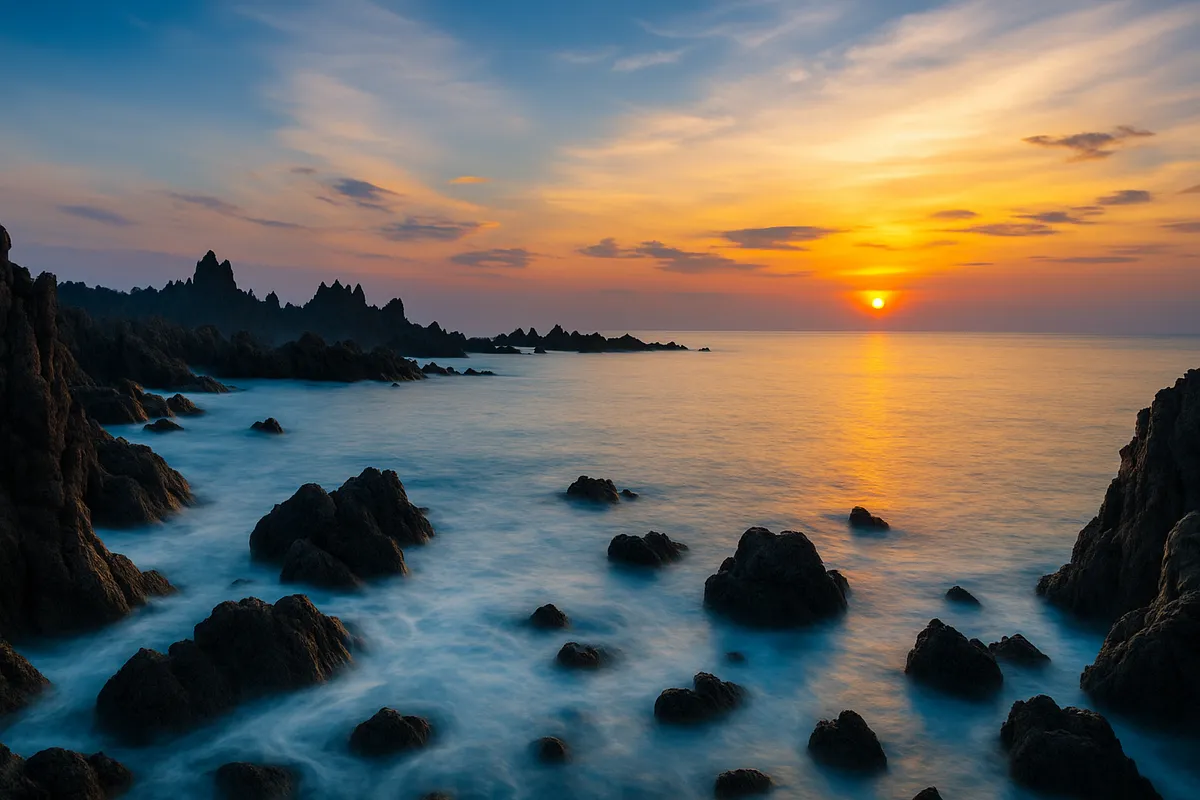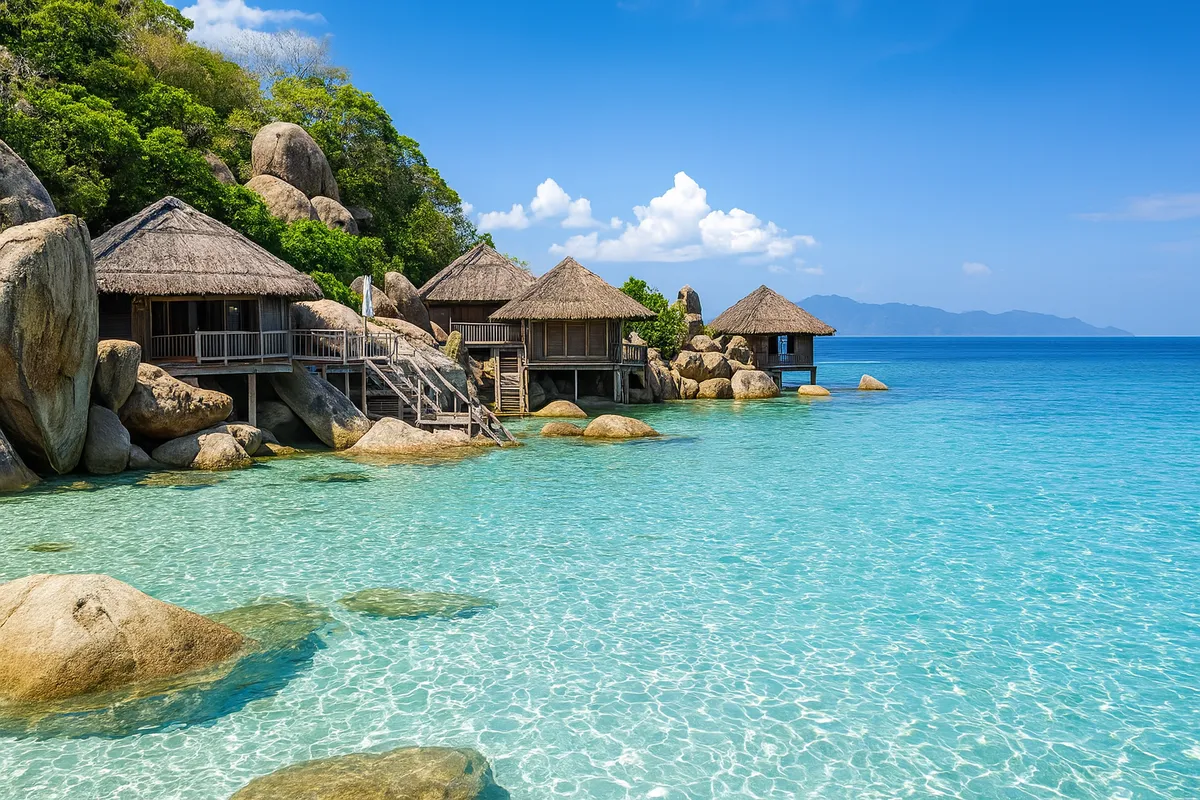Lan Chau Island and the love song between Cua Lo sea waves
- Friday, May 30, 2025, 14:36 (GMT+7)
Lan Chau Island and the love song between Cua Lo sea waves
Lan Chau Island is a name that echoes like the call of the sea breeze, evoking a land both melancholic and irresistibly captivating. Tucked beside Cua Lo beach, this small island feels like a forgotten fairytale, a silent poem nestled in the never-ending symphony of waves, wind, and time. Some say it resembles a giant toad reaching toward the sea, others affectionately call it Ru Coc, a name that preserves the soul of the homeland in each moss-covered rock.
Each pure morning, before sunlight reaches the lazy sails offshore, Lan Chau emerges through a veil of mist like a gentle mirage. The winding stone steps challenge each stride, guiding travelers into a space that feels both real and dreamlike. There, the water glimmers silver, the sand slopes gently like a ribbon infused with the scent of salty wind, and the dark jagged cliffs stand solemn like prehistoric gods.
Halfway up the island stands an old structure gazing out over the ocean. This is Lau Nghinh Phong, once chosen by King Bao Dai as a summer retreat. It is neither elaborate nor radiant, yet it bears a royal and tranquil charm, as if each brick has captured the footsteps of the past, nameless memories that still linger. From this vantage point, one does not just see the vast sea but hears time echoing from the rocks, the clear sky, and the breeze sweeping through stone crevices that have witnessed countless tides.
A local legend has been passed down for generations about a woman named To Nuong who turned to stone while waiting for her husband. They say the uneven rocks at the base of the island are her transformed form. At sunset, her silhouette reflects upon the sea like a motionless figure, carrying a melancholic ballad from the ocean. Each wave crashing ashore feels like a sigh, a whispered story from the past.
Lan Chau is not noisy. There are no bustling amusement parks or dazzling lights. Time seems to pause here, allowing one to feel each leaf falling, each ripple brushing against the rocks, and the salt air gently filling the chest. It is a place that makes people feel small yet whole, where every sense awakens in the stillness of nature.
When the tide rises, the island's base submerges, turning Lan Chau into a peninsula floating in the deep blue sea. It is a magical moment when the island seems to break away from the mainland, like a bird taking flight in freedom. Perhaps because of this, people once believed the island could drift or even fly with strong enough winds and a sincere heart.
Under the noon sun, the rocks at the tip of Lan Chau shimmer with a turquoise glow, an unusual blue not often seen along central Vietnam’s beaches. It is not an illusion but a result of unique geological formations, turning the island into a natural cinematic backdrop for photographers and lovers of slow living. It is no wonder that young travelers call it “the place where the sun sets slowest in Cua Lo.” From the island peak, as the evening light slants, the sun appears to sink into the sea like a slow, mesmerizing film.
Lan Chau holds a quiet secret: beneath the island’s tip lies a network of small caves, revealed only when the tide recedes and the sky is clear. The low stone arches curve like a fairy tale grotto where echoes of waves bounce like songs calling out. Local fishermen take shelter there during rain, and children excitedly search for crabs and shells while swapping tales of sea dragons.
At the far end of the island stands a modest lighthouse, pure white and peaceful. It is not tall like the lighthouses of the south or striking like the one at Co To, but its location is special at the edge of the storm, guiding fishing boats home through the night. That light is a symbol of return, of quiet perseverance and peace, shining steadily for those far away.
In terms of timing, summer is when Lan Chau is at its most radiant. When the waves dance beneath the June sun, the sea glows as if covered in gold, reflecting a warm light off each rocky surface. In March or April, when sunflowers bloom along the sandy slopes nearby, the island takes on a new hue, vibrant, youthful, and full of life. During winter, the sea turns cold and somber, but this emptiness soothes those seeking calm.
The journey to Lan Chau is not complicated. From the center of Vinh city, it takes less than an hour to reach Cua Lo. From the beach, a narrow path leads over a stone bridge connecting the mainland to the island. That humble bridge feels like a silk ribbon stretching between the present and memories, just wide enough for footsteps to slow the heart.
Each afternoon, as the sun tilts west, the scent of grilled seafood drifts in the sea breeze, mixing with the warm sand and damp moss, creating a distinct aroma felt only in Lan Chau. There, one hears the wind slap against the cliffs, sees children skip along the water’s edge, and feels a gentle peace settle deep within.
A must-try dish is freshly caught jumping squid, grilled right on the sand. It is simple yet rich with the flavor of the sea. No fancy plating, no elaborate spices, just pure white squid melting in the mouth with a sweetness that cannot be mistaken. Locals still prefer using charcoal, letting the glowing fire illuminate a tranquil afternoon by the shore.
Lan Chau is not meant for the hurried. It is for those who love the sea, who admire stones, and who listen to the breath of nature. On windy afternoons, the flag at the island’s peak flutters in the sunset glow, and the one standing below looks up to feel the sky softening.
In a moment of golden sunshine, standing at the island’s edge facing the boundless sea, a thought may quietly arise: “Not every place makes people silently happy.” Lan Chau is one of those rare places. It is not loud, not showy, just a sunbeam tilting over the water, a horizon that stretches endlessly, and a breath of serenity that fills the soul.
And perhaps, every time someone leaves, they leave behind a part of their heart on those mossy rocks, where land becomes poetry, where the sea tells stories, and where the wind has never known rest.

 CHECKIN.VN
CHECKIN.VN








Share on